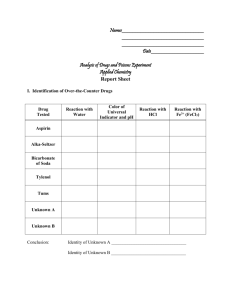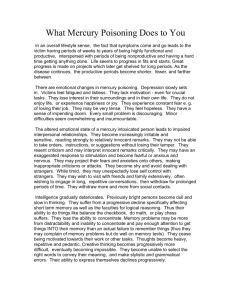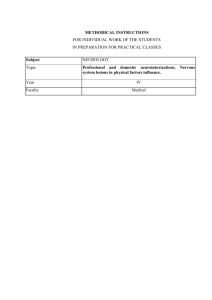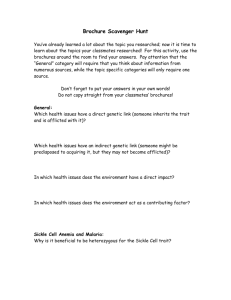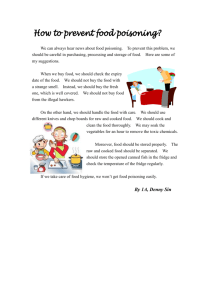02. Intoxication by lead and benzol
advertisement
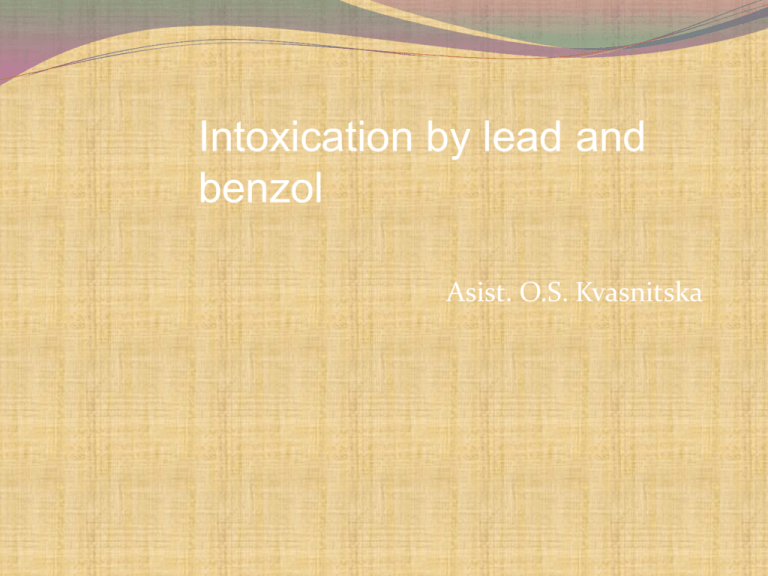
Intoxication by lead and benzol Asist. O.S. Kvasnitska Neurotoxikosis – is an occupational intoxication, in which central and peripheral nervous system mainly affect Cinnabar or mercuric sulfide, the only known ore of mercury Benvenuto Cellini Hg – Like Water Chemistry and Toxicokinetics Elemental Mercury Synonym: Hydrargyrum B Liquid silver Metallic mercury Formula: Hg Valence: 0 Molecular Weight: 200.59 Chemical State: Elemental Physical State: Heavy Liquid Toxicity: High Threshold Exposure Limit: 0.01 mg/m3 Organic salts Mercuric (II) Acetate Methylmercuric Chloride Methyl Mercury Dimethylmercury Thimerosal Phenylmercuric acetate Mercury Release 50-75% mercury of released in the environment related to human activities Environmental Sources of Mercury • Natural Degassing of the earth • Combustion of fossil fuel • Industrial Discharges and Wastes • Incineration & Crematories • Dental amalgams Hg0 Hg2+ CH3Hg+ The Mercury Cycle Pathogenesis Protein precipitation Enzyme inhibition Generalized corrosive action Acute intoxication hypersalivation, inflammation and formation of ulcers of mucous of the mouth swelling of salivary glands, increase of submandibular lymph nodes, inflammation of gums, nausea, vomiting, diarrhea, tenesmus, intestinal colic. Inorganic salts Mercuric (II) Chloride Mercuric (II) Sulfide Mercurous (I) Chloride Mercurite Nitrate Synonym Bichloride of mercury Mercury perchloride Vermilio Red mercury sulfide Calomel Mercury monochloride Mercury protochloride Mercury pernitrate Formula HgCl2 HgS Hg2Cl2 HgN2O6 Physical State Solid Solid Solid Solid Toxicity High to Moderate High to Moderate Moderate to Low High to Moderate Mercury poisoning Necrotizing nephrosis Chronic mercury poisoning Initial stage or the stage of “mercury neurasthenia” Has reverse development and little symptoms Clinical symptom grows gradually Patients complaints of: general weakness, headache, tearfulness, decline of memory, bad sleeping, feeling of metallic taste in mouth, considerable salivation, dyspeptic disorders. Objective examination: Neurasthenic syndrome with vegetative disfunction emotional lability, vegetative violations, proof red dermographism, rapid appearance of erythematous spots, instability in the Romberg’s pose limb tremor salivation and gums hemorrhage, gingivitis and stomatitis. At timely treatment and stopping of contact with mercury all signs of disease disappear fully, a capacity is not violated. The stage of the moderate expressed changes (mercury erythism) 1. Astenovegetative syndrome: - a sharp weakness, - permanent headache - insomnia, - tearfulness, - propensity to depressions 2. Symptoms of abnormal psychologies: - inadequate bashful - lack of confidence during work, - emotional lability 3. Endocrine-vegetative disfunctions (a thyroid is often enlarged with the symptoms of hyperfunction) 4. Changes from the side of the cardiovascular system - tachycardia, - arterial hypertension. 5. Changes from the side of gastrointestinal tract - gastritis, colitis, - is more expressed feeling of metallic taste in mouth, increased salivation, parodontos, gums hemorrhage. 6. In blood: - lymphocytosis, - monocytosis, - rare anaemia, - leucopenia, - the table of contents of mercury in urine is from 0,02 to 0,9 mg/l. 7. Neurocirculatory disorders flow as diencephalic insufficiency. Patients have paroxysms, which are accompanied by dizziness, heart pains of angiospastic character, general hyperhidrosis, supercooling of extremities and pallor of skin and expressed emotional reactions Stage of the expressed changes, toxic encephalopathy. Proof organic changes can develop at progress of pathological process. Very quickly this stage makes progress after psychical traumas, heavy infections, in a climacteric period. MERCURY POISONING DIAGNOSIS Early typical symptoms: irritability, weakness, Gingivitis stomatitis. Confirmation of diagnosis is mercury determination in urine and feces. Presence of mercury in urine without proper clinical symptoms indicates a “mercury carriage”. Treatment Choice of treatment depends upon the form of mercury involved Supportive care: the ABC (airway, breathe, circulation) Skin: decontamination may involve copious irrigation of the exposed area Gastric lavage with protein-containing solutions: (eg, milk, egg whites, salt-poor albumin) or 5% sodium formaldehyde sulfoxylate solution may bind gastric mercury and limit its absorption Treatment Thiol-containing chelating agents: dimercaprol (BAL) 2,3-dimercaptosuccinic acid (DMSA, succimer) 2,3-dimercapto-1-propane sulfonic acid(DMPS) sodium 4,5-dihydroxybenzene-1,3-disulfonate (Tiron, Unitiol) penicillamine Treatment Drugs which improve metabolism and blood supply of brain (Pyracetam, Stugeron). Glucose 40% 20 ml + Vit. C Vit.B 1, B 12, B 6 Tranquilizers Symptomatic therapy MANGANESE POISONING Properties of manganese A gray-white or silvery brittle metallic element, occurring in several allotropic forms, found worldwide, especially in the ores pyrolusite and rhodochrosite and in nodules on the ocean floor. It is alloyed with steel to increase strength, hardness, wear resistance, and other properties and with other metals to form highly ferromagnetic materials. Atomic number 25; atomic weight 54.9380; melting point 1,244°C; boiling point 1,962°C; specific gravity 7.21 to 7.44; valence 1, 2, 3, 4, 6, 7. Electrolytically refined manganese chips and 1 cm3 cube Manganese (II) chloride crystalls Aqueous solution of KMnO4 Manganese poisoning Pathogenesis Two phases of the manganese action I phase – cholinergic – is characterized by predominance of cholinergic influence. II phase – phase of areactivity – injury of acetylcholinoreactive structures. A manganese influences on the function of thyroid, cardiovascular system, gastrointestinal tract, liver and other. Micrographs of control and manganese-exposed rat primary striatal neurons. (A) and (B) Hoffman modulation contrast micrography of in situ end labeling of DNA in rat primary striatal neurons exposed for 48 h to either 0 or 5 μM added MnCl2, respectively. (C) and (D) Fluorescence microscopy of microtubule-associated protein immunohistochemical labeling in rat primary striatal neurons exposed for 48 h to either 0 or 5 μM added MnCl2, respectively. Scale bar: 1 μm. Routes of manganese in the human body Respiratory system Gastrointestinal tract Skin Clinical picture Three stages of manganese poisoning First stage. This stage characterized by the functional changes Patients complaint of: rapid fatigueability, somnolence, headache which arises up at the end of working day, weakness, loss of appetite, salivation, nausea and pains in a stomach, related to the use of meal appears, paresthesia and pains in the distal departments of extremities. During objective observation there are no any changes of central nervous system and vegetative dystonia In peripheral blood in the initial stage of intoxication there is: lymphocytosis, monocytosis, change of leukocytosis formula to the left. Second stage – initial stage of toxic encephalopathy. Insignificant organic symptoms appear in this stage on a background of astenovegetative syndrome. In patients may be the liquid blinking, hypodynamia, positive symptoms of oral automatism (symptom of Marinesko and trunk). Muscles tones rises, disorders of walking, a somnolence, sluggishness, appears. Objective examination Missing at pointing test Instability in the Romberg posture Tremor of stretch hands fingers Polyneurotic syndrome, which is more expressed with development of trophic changes of skin and considerable changers of sensetivity Appearance of diencephalic crises. The third stage is a manganese Parkinsonism. A characteristic diffuse affection of cerebrum is with overwhelming growth of extrapyramid symptoms. In this stage patients have a masklike face, they are languid, not mobile, motions are very slow, sometimes there is emotional derangement which is accompanied the forced laughter and weeping. MANGANESE POISONING DIAGNOSIS Special attention is paid to early diagnosis of chronic manganese poisoning. Professional route sanitary description of labor conditions (manganese concentration in the workplace, duration of contact during work day, experience of work, influence of other harmful professional factors), to analyse results of biochemical investigations (level of manganese in blood, urine, saliva, milk) MANGANESE POISONING Treatment Avoid contact with manganese Glucose 40 % + Vit.C (300-500 mg) i/v, vitamin B1 (40-50 mg), 0,25 % novocaine 10-15 ml (15-20 injections). At appearance of Parkinsonism signs it is necessary to prescribe antiparkinsonism cholinolytics (Cyklodol, Norakin, Amedin, Tropacin, tab. “Karbella”) Tropacinum – is effective antiparkinsonism cholinolytical drug (10-20 mg 1-2 times per a day after meal). “Karbella” decrease tremor and diminish tonus of muscles (1 tablet before sleep). Substance identification Formula: Pb(C2H5)4 Synonyms: TEL; lead tetraethyl; motor fuel antiknock compound Appearance and odor: colorless liquid (or dyed red, orange, or blue) with a slight musty odor TEL in industry TETRAETHYLLEAD POISONING MODE OF ABSORPTION INHALATION SKIN INGESTION Acute poisoning with tetraethyl lead with significant pollution tetraethyl lead of the environment accidents or in case of accidental dousing body massive tetraethyl lead or ethyl fluid after accidental ingestion of these substances Three stages of the acute poisoning by ТЕL: - initial, - preculmination, - culmination. The initial stage is characterized by: headache, expressed weakness, vomit, enhanceable salivation, insomnia, nightmare, and muscles weakness, vegetative disorders: bradycardia, arterial hypotension, hypothermia parastesias for as a crawl of ants on a body, and also itch of body and feeling of hairs in mouth. Objective examination: Tremor of fingers of stretch hands Instability in the pose of Romberga, dysartria, uncertain step, tendon reflexes are enhanceable In clinical picture there are following syndromes: asthenic, organic (syndrome of encehpalopathy) or pseudo paralytic and predelirium Preсulmination stage of the acute poisoning by ТЕL is characterized: more expressed psychical and vegetative disorders which are accompanied auditory, visual and tactile hallucinations, patients become aggressive, ataxia, tendon reflexes, pathological reflexes, are enhanceable (Rosolimo, Opengeim, Babinsky). The culmination stage of the acute poisoning by ТЕL flows heavier that others stages. Clinically there is the expressed psychomotion excitation. Consciousness is darkened, hallucinations, psychosensoric and vegetative trophic disorders. Epileptiform attacks are possible. CHRONIC TETRAETHYLLEAD POISONING observed in workers who worked in contact with low amounts of ТЕL during long period. A clinic develops gradually and can be poorly expressed. There are three stages of the chronic poisoning: I-st (initial), II-nd III-rd The first (initial) stage is characterized by the processes of hampering in central neural system. Patients complaints for: a general weakness, rapid fatigability, by the decline of attention, parahypnosis, enhanceable irritability, feeling of fear, depression, paresthesias with feeling of hairs in mouth, feeling of “crawl of ants” on a body. There is hypotonia, hypothermia, bradycardia. The decline of libido and potency is possible. The II-nd stage of poisoning is characterised by development of toxic encehpalopathy. In neurological status is shaking of fingers of hands, unsteady walking, nystagmus, dysarthria, tendon reflexes are enhanceable. The decline of intellect, limitation of interests is marked in addition. The conduct of patients becomes not enough adequate. In the III-rd stage of poisoning there are more expressed changes in a psyche, psychomotion excitation is marked. At the III-rd stage of poisoning proof changes, which are characterized the decline of intellect, violation of memory and sleep, are often marked. For patients who carried the heavy forms of the chronic poisoning by ТЕL after some time there can be the remaining phenomena in a kind: expressed astenization, emotional instability, and decline of memory, parahypnosis, vascular and endocrine disorders. ACUTE TEL POISONING Treatment To wash up skin (with warm water and soap), to make gastric washing, to use absorbents. Patients with acute TEL poisoning need complete rest, hypnotic medicines from the group of barbituratus (phenobarbital, barbital sodium or etaminal sodium). At hyperexcitability barbamil (i/m or i/v) or hexenal are prescribed. hypertensive solution of glucose i/v, Vitamine therapy. Warm baths are recommended before sleep. CHRONIC TEL POISONING Treatment Treatment of patients with the chronic form of TEL poisoning is appointed taking into account expressiveness of clinical manifestations. For such patients - drugs which influence on a tissue metabolism (glutamine acid, glucose, vitamins C, B1, B2, ATF, riboxin), - tranquilizers (Diasepam, Tazepam) are recommended. Intoxication by lead Lead Physical Properties Lead (Pb) has been used by humans for at least 7000 years, because it is widespread, easy to extract, and easy to work with. It is highly malleable and ductile as well as easy to smelt. Lead’s elemental symbol Pb, is an abbreviation of its Latin name plumbum . Metallic lead (Pb0) is resistant to corrosion and can combine other metals to form various alloys(Lead alloys are used in batteries, shields from radiation, water pipes, and ammunition) Inorganic Lead Organic Lead Lead has no known biological function. Uses and Sources of Lead: Lead paint: Food containers (painted with lead-based paint or lead-containing glaze , canned foods) Petrol (tetraethyl lead) Toys and Jewelry Herbal remedies from India, China, and other parts of Asia may be potential sources of lead exposure. Uses and Sources of Lead: Soil: Exposure to soil that contains particulate lead has been shown to be significantly hazardous for children, who are more commonly exposed by ingestion of house dust or soil than by paint chips. Water: Drinking water is also a major source of lead Exposure. Occupational sources: Remodeling construction Smelters Battery factories Ammunition Contribution of Sources Ayurvedic Traditional Remedies Numerous reports of lead, mercury, thallium, arsenic poisoning from Ayurvedic (& Chinese) remedies 40% of the >6000 medicines in Ayurveda contain at least one heavy metal Thought by practitioners to have therapeutic properties and/or to increase the efficacy of other herbal contents Used most commonly for chronic disorders and so there is a greater risk of heavy metal accumulation Lead Compounds Lead carbonate 2PbCO3Pb(OH)2 – Paint pigment (basic white lead) and additive Lead Compounds Lead oxide Pb3O4 – Used as a pigment (red lead) in inks and dyes, and as primer for rust protection on metal. Lead oxide in wrapper contaminating candy from Mexico Lead Compounds Lead chromate PbCrO4 – Used as a pigment in inks and dyes, and as an artist paint pigment (chrome yellow) Lead Compounds Tetraethyl lead Pb(C2H5)4 – Antiknock additive to gasoline. Though lead was completely phased out of gasoline by 1995 in the U.S., lead particles emitted in engine exhaust still persist in some soil near major roadways. Lead Compounds Tetraethyl lead Pb(C2H5)4 – Antiknock additive to gasoline. Though lead was completely phased out of gasoline by 1995 in the U.S., lead particles emitted in engine exhaust still persist in some soil near major roadways. Lead Compounds Lead arsenate Pb3(AsO4)2 – Insecticide Lead Compounds – Cartridge primers, primer cord for explosives Lead azide Pb(N3)2 Lead azide is a rare source of lead contamination, as most people in the general public will not be working with explosive devises. Lead Compounds Lead silicate PbSiO3 – Glazes for china, porcelain, tiles The Roman techniques of glazing were most likely discovered sometime in the first century B.C. However, it is important to note that lead glazing holds a long history in the ancient world which spans far before Roman times. After the Roman period, the tradition spread and eventually the process became a practice for mass produced ceramics. Lead Compounds Lead sulfide PbS – Most abundant lead ore. Lead sulfide is the most abundant lead ore. The Gingival “lead line” pictured, also known as the “Burton line,” represents precipitation of lead sulfide along the gum line and is associated with lead toxicity and poor oral hygiene. Lead Exposure in Children and in adults Organ Systems Damaged by Lead Poisoning Brain Disorders Hematological Problems Nerve Disorders Kidney Problems Decreased Red Blood Cells Reproductive Problems Slower Reflexes Lead in the Body “Body Burden” of lead - the amount of lead stored in the body. Lead is a cumulative poison. Effects of Lead on the BloodForming System Lead impairs the formation of “heme” which is extremely important to human life because it carries oxygen to tissues of the body Anemia and Lead Toxicity Normochromichypochromic, normocyticmicrocytic Reduced rbc survival time Compensatory rbc production reticulocytosis Basophilic stippling variable represents damaged cell organelles, RNA Effects of Lead on the Kidneys Interferes with absorbing function of kidneys Chronic nephropathy (kidney disease) AFFECTION OF GASTROINTESTINAL SYSTEM LEAD COLIC 1)Severe Abdominal pain 2) ↑ AP (>200/100) 3) Untreatable constipation Other Health Effects of Lead Exposure Hypertension - long-term, high exposures Reproductive system Males decreased sex drive decreased sperm count and motility, altered structure impotence and sterility Females difficulty becoming pregnant; miscarriages Mechanisms of Damage to the Nervous System by Lead Central Cerebral edema Necrosis of brain tissue Glial proliferation around blood vessels Peripheral Demyelination Reversible NCV Irreversible axonal degeneration Diagnostic Criteria for Lead Toxicity (CDC) Analysis of lead in whole blood is the most common and accurate method of assessing lead exposure. Erythrocyte protoporphyrin (EP) tests can also be used, but are not as sensitive at low blood lead levels (<20 μg/dL). Lead in blood reflects recent exposure. ƒ Bone lead measurements are an indicator of cumulative exposure. ƒ Measurements of urinary lead levels and hair have been used to assess lead exposure; however, they are not as reliable. Normal human levels Lead levels in blood (geometric mean, 1999-2002): 1.9 μg/dL for children 1-5 years 1.5 μg/dL for adults 20–59 years Lead levels in urine (geometric mean, 2001-2002): 0.677 μg/L for ≥6 years of age Chelating agents for lead poisoning 1. EDTA - Sodium calcium edetate 2. DMSA - Dimercaptosuccinic acid 3. BAL - Dimercaprol - IM for severe toxicity only, particularly encephalopathy 4. Penicillamine - no longer recommended EDTA and DMSA • EDTA - Sodium Calcium Edetate - IV for severe toxicity, particularly encephalopathy - Well tolerated, <1% nephrotoxicity • DMSA - 2,3dimercaptosuccinic acid - The oral agent of choice for lead poisoning - Given as a 19 day course - Well tolerated - The main problem is foul taste and smell !! Treatment guidelines Adults 100-400µg/l : Remove from source (??) : Repeat level 3-6 mths 400-500µg/l : Remove from source (?) : Repeat level 1-2 mths 450-690µg/l : Remove from source : DMSA chelation IF symptomatic >700µg/l : Remove from source : DMSA chelation : EDTA if neurological features Thanks for attention!
